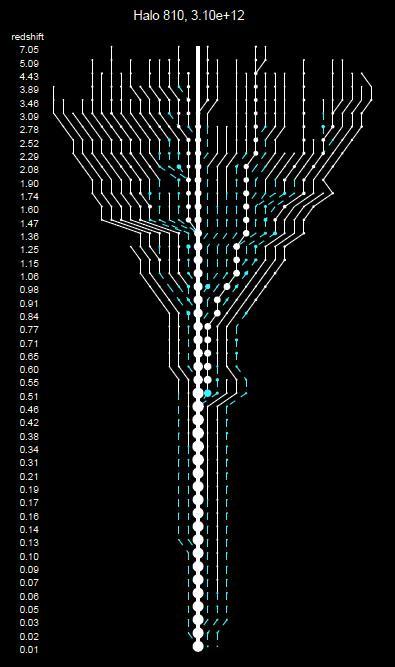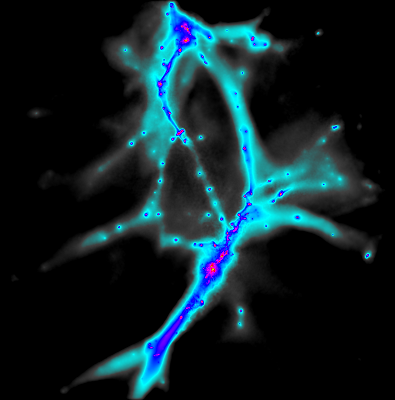
The figure above shows an example "merger tree" showing the merger history of a single, Milky Way-size dark matter halo over cosmic time, extracted from a cosmological N-body simulation. The redshift of each snapshot is printed on the left-hand side. White lines represent isolated halos that will eventually merge into the main progenitor halo (the center line). White lines become cyan when these infalling halos cross the main progenitor's virial radius. This image (colors modified) is taken from my first paper, Stewart et al. (2008).
Dark Matter Halo Merger Histories
One aspect of my research involves studying the merger statistics of dark matter halos from cosmological N-body simulations. Under the presumption that our current understanding of LCDM cosmology is reasonably sound, it is possible to provide very robust predictions for the merger histories, accretion rates and formation histories of dark matter halos, if we only concern ourselves with dark matter (adding baryons makes things so much more complicated!) For the bulk of my thesis work, I used DM merger trees to infer qualitative and quantitative properties of galaxy formation, focusing on roughly Milky Way-sized systems.
"Semi-empirical" Galaxy Formation Models
In order to infer some about the formation of galaxies themselves (not just the dark matter halos they live in), Some of my research makes use of various empirically-motivated means of estimating the baryonic content of DM halos as a function of halo mass and redshift. The advantage to this approach is that the underlying DM merger histories are fairly robust predictions of LCDM. Because baryonic properties of DM halos in these models are defined in such a way as to reproduce observed constraints (for example, the stellar mass function of galaxies as a function of redshift) the implications from these "semi-empirical" galaxy formation models can produce relatively robust predictions about galaxy formation in LCDM.

The figure above shows the projected density of cold gas in an example hydrodynamic simulation at z=2, with an image width of 5 co-moving Mpc. Low density gas is shown in gray, with high density gas in blue and red. Note the complex, filamentary nature of the large scale structure in the universe.
Hydrodynamic Simulations
More recently, my research has involved running fully cosmological smooth particle hydrodynamic (or SPH) simulations, including treatment of gas cooling, star formation, and star formation feedback. While the results of such simulations are a bit less robust than pure DM merger histories (primarily due to uncertainties in the nature of star formation and feedback processes) hydrodynamic simulations give a much more "hands-on" way to compare theory and observations. With the inclusion of baryons, there are a great number of topics available for comparison that would prove difficult using DM-only simulations, such as gas accretion history, detailed galaxy morphology comparisons, star formation histories, and much more.